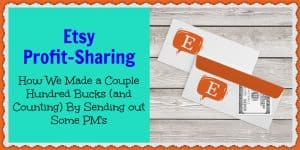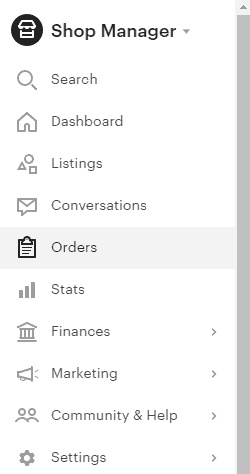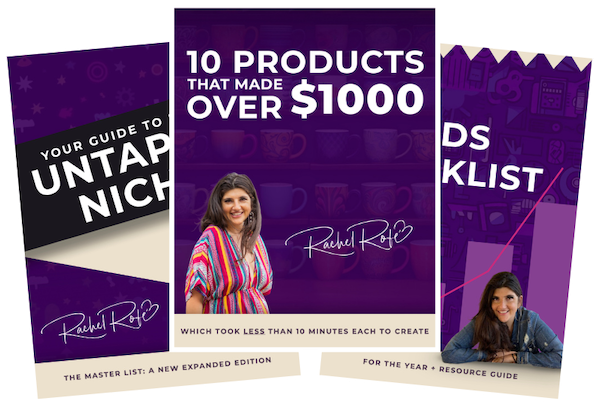Partnerships can be a fantastic way to increase your sales and tag-team your marketing efforts, thus significantly expanding your reach. And Etsy is a great hub to find people to collaborate with.
You don’t even need to have an Etsy shop yourself. But if you want to find talented designers and artists who’d be willing to let you use their creations on your products, then Etsy is the place to look.
I recently partnered with two Etsy sellers following the process detailed below. So far, I’ve been pleased with the results and so I wanted to share the strategy with you, too.
Basically, how it works is you reach out to Etsy sellers who have designs or artwork you think would look great on your products (mugs, pillow cases, shot glasses, t-shirts, etc.). Then, you form a mutually beneficial partnership in which you create new items to sell using their designs and then give the sellers a cut of the profits each month.
It’s a pretty simple process that can yield significant results, especially if you form multiple partnerships. And below, I go over everything you need to know.
Here’s how the process worked
My assistant ran searches on Etsy for things like paintings, artwork, and print wall art. She also searched for more niche-specific items, such as dog prints and dog watercolors.
Then, after scrolling through the various items, she selected those she thought would make nice designs for my products, including mugs, tumblers, and pillow cases. Next, she contacted the sellers.
You can do this by clicking on the Etsy shop’s name and then clicking “Contact” under where the shop owner’s name is listed on the right-hand side.
Here is the exact message template we used:
Subject: I love your [product type]!
Hey [first name],
My name is [your name], and I’ll keep this as short as possible since I know your time is valuable.
I’m reaching out because I absolutely love your [Etsy seller’s product(s)]! And I think a collaboration between our two Etsy stores would be a natural fit and a total win-win.
My shop is [your shop’s name], and it specializes in [items you sell].
And if we were to put your artwork on [your shop’s name] products, I think it would create something really special that both of our audiences would love.
Please let me know if this is an opportunity you’d be interested in discussing further.
Thanks so much!
Best,
[your name]
What happened next…
Out of the 40 or so people we contacted, 4 sellers said they were interested so we sent them this follow-up message:
Hey [first name],
Thank you for getting back to us!
Ideally, we’re looking to profit share with you. And the way that would work is you’d give us your design files and we’d put your designs on our mugs, pillowcases, tumblers, etc.
In exchange, we’d give you 20% (because we only have so much profit; we are willing to negotiate, however). And in the product’s description, we would link to your store so our customers could see more of your designs/artwork.
Then, if you could tell your audience that your designs are also available over on our Etsy page, a shout out like that would be great!
We hope this sounds like a good win-win! What do you think?
Thank you!
Best,
[your name]
All four sellers ended up agreeing to the 20%. And three out of four agreed to be paid monthly via PayPal (be sure to collect each seller’s PayPal email address). The fourth person wanted to receive checks quarterly instead, though, since she lives in Canada and is unable to receive e-tranfers.
After some more back-and-forth communication, one seller eventually became non-responsive. And after submitting one design to us that we printed on a mug, another seller decided our partnership wasn’t a good fit for her business model after all.
So then we were left with two sellers, both of whom have been great to work with.
Partnering with two fantastic Etsy sellers
Seller #1 has submitted 42 designs (as PNG files) to us so far. And seller #2 has submitted 11.
You can have sellers email you the files, or the sellers can submit them to you via Dropbox or Google docs.
(Note: Seller #1 wanted us to sign a contract laying out some terms to protect her art and Etsy shop. It was all standard and not an issue to sign.)
We put the designs of both seller #1 and seller #2 on mugs to start to see how they’d perform. And at the end of each mug’s description, we included a shout-out to the seller as promised.
Here’s what that shout-out looked like:
To see more amazing [product type] designs like the one featured on this [product], check out [Etsy seller’s shop name] shop at [Etsy seller’s shop link].
Seller #1’s designs have been performing decently so far. And sales have been picking up lately, most likely thanks to the holiday season.
But for seller #2’s designs, no sales were made in the first month. So we decided to branch out and also put her designs on tumblers and pillow cases. We’ve now seen two pillow case sales come in for her.
Keeping track of sales
My assistant created a spreadsheet to keep track of the following information:
- Seller name
- Seller contact info (PayPal email or address if checks are being sent)
- Seller’s Etsy store name
- Seller’s Etsy store link (to include in the items’ descriptions)
- Design name (e.g. Golden retriever watercolor, ‘Hope’ word art)
- Etsy listing link (the link to the product we created using the seller’s design)
- Payout percentage (20% unless otherwise noted)
- Month – Under this column heading and next to the design name, you can note how many of each item was sold, on what date, and for what price (e.g. 1 – 11/25 – $14.95)
Then, at the end of each month, we tally up the total sales made for each seller, multiply that number by .20 (20%), and send that amount to the seller.
We also send the sellers an email to let them know how many of their designs sold and when they can expect their payouts.
Here are the results (so far):
There have been 20 sales so far for a total of $296 in revenue.
- 2 pillow case – $9.95
- 13 mugs (11 oz) – $14.95
- 4 mugs (15 oz) – $17.95
- 1 mug (15 oz plus shipping) – $24.90
The pillow case sales were under-priced but we still made revenue on every item, even factoring in expenses.
As previously stated, the Etsy sellers get 20% of each sale made. So factoring that in, $248.76 of this total was profit for me.
The consensus
This is a pretty easy strategy to implement. The most time-consuming part was the initial back and forth with the sellers to make sure everyone was on the same page and content with the arrangement.
After that, it takes just 5-10 minutes of work a day (I recommend checking your Etsy orders daily, especially if you have a high sales volume, as doing so helps you stay more organized).
And in case you’re not familiar with how to check your orders, here’s what to do:
- Login to your Etsy account.
- Click “Shop Manager.”
- Go to “Orders.”
- Click “All.”
- Scroll through looking for any orders for one of the Etsy seller’s designs.
- Note these sales on your spreadsheet.
So, without needing to spend a ton of time — or any money — getting this strategy up and running and maintaining it, I’ve seen an extra $248.76 in profits in around 2 months. And if I were to continue recruiting even more Etsy sellers to profit-share with me, I’m sure I’d see even more revenue.
Both of the Etsy sellers I’ve been working with also said they’d promote the products with their designs to their social media followers — the more sales I make, the more money they make, after all!
This strategy is a total win-win. And overall, I’d say it’s definitely worth trying for yourself.
What do you think? Do you think this Etsy profit-sharing strategy is something you’d like to try? Please leave a comment below and let me know!







